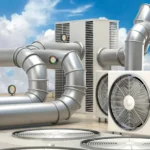Swapping a Cummins diesel engine into a different vehicle platform—whether it’s a Ford, GM, Jeep, or older Dodge—is one of the most powerful upgrades you can make for torque, durability, and performance. But making that swap work mechanically requires more than just dropping the engine in. One of the most essential components in this process is the transmission adapter plate.
In this article, we’ll break down what a transmission adapter plate is, why it’s critical for Cummins engine conversions, how to choose the right one, and what you need to consider before buying.
What Is a Transmission Adapter Plate?
A transmission adapter plate is a precision-engineered metal plate that allows you to connect a transmission from one vehicle manufacturer to an engine from another, specifically, in this case, a Cummins diesel engine. It compensates for differences in bolt patterns, alignment, spacing, and crankshaft positioning between incompatible components.
For example, if you’re installing a 5.9L 12-valve Cummins into a 1990s Ford F-250 with an E4OD transmission, you’ll need a transmission adapter plate designed to bridge the Cummins block to the Ford bellhousing pattern. Without the right plate, the engine and transmission simply won’t mount or function together.
Why Adapter Plates Matter in Cummins Swaps
Cummins engines are extremely popular for swaps due to their reliability and torque. However, since most Cummins blocks are originally mated to Dodge transmissions, they are not a plug-and-play solution for Ford, GM, or other vehicles.
Here’s why transmission adapter plates form one of the most important Cummins conversion parts:
- Compatibility: Different automakers use different bolt patterns, crankshaft spacing, and torque converter setups. An adapter plate ensures everything aligns properly.
- Structural Integrity: These plates maintain structural alignment between the engine and transmission, reducing wear and stress on mounting points.
- Preserve Existing Drivetrain: They let you retain your factory transmission (and often transfer case), reducing the cost and complexity of full drivetrain replacement.
- Conversion Versatility: Whether you’re using a manual (ZF5, NV4500) or automatic (4L80E, E4OD, Allison), there’s likely an adapter solution available for your project.
Common Adapter Plate Applications for Cummins
Some of the most common transmission adapter plates are designed for the following Cummins engine swaps:
- Cummins to Ford (E4OD, 4R100, ZF5, ZF6)
- Cummins to GM (TH400, 4L80E, 6L90, Allison 1000)
- Cummins to Jeep (AX15, NV3550)
- Cummins to Dodge (when mixing generations)
These kits usually include the adapter plate itself, flexplate or flywheel, torque converter spacers, hardware, and sometimes starter relocation brackets.
How to Choose the Right Transmission Adapter Plate
When selecting an adapter plate for your Cummins conversion, consider the following factors:
1. Engine Model and Year
Know the exact model of your Cummins engine—whether it’s a 12-valve 5.9L, 24-valve 5.9L, or 6.7L common rail. Mounting surfaces and crankshaft dimensions can vary slightly.
2. Transmission Type
Is it a manual or automatic? Does it have an external or internal bellhousing? This affects plate thickness, starter alignment, and torque converter spacing.
3. Vehicle Platform
Your base vehicle determines which mounts, driveshaft lengths, and electronics may be compatible.
4. Starter and Flexplate Positioning
Some swaps require relocating the starter to the opposite side or changing the flexplate/flywheel tooth count to match the transmission.
5. Off-the-Shelf vs. Custom
Many popular swaps have pre-made kits available from companies like Destroked, Forcum Engineering, or Scheid Diesel, but less common combinations may require custom fabrication.
Benefits of Using a Quality Adapter Plate
Investing in high-quality transmission adapter kits pays off in performance and reliability:
- Precision Fitment: CNC-machined plates ensure perfect alignment.
- Reduced Vibration: Proper mating of the engine and trans reduces strain on the drivetrain.
- Ease of Installation: Well-designed kits often come with all required bolts, dowels, and alignment tools.
- Resale Value: A properly mounted engine/transmission combo improves your swap’s long-term value and durability.
Installation Tips
- Test fit first. Before torquing everything down, loosely assemble the engine, plate, and transmission to ensure everything lines up.
- Use torque specs. Follow manufacturer-recommended torque settings for adapter plate bolts and hardware.
- Check starter clearance. Always verify that your starter aligns and engages correctly with the flywheel.
- Don’t skimp on quality. Cheap or ill-fitting plates can lead to misalignment, causing transmission failure or premature wear.
Final Thoughts
A transmission adapter plate is one of the most critical components in any Cummins conversion project. It allows you to retain your preferred transmission while harnessing the power of a Cummins diesel engine. Whether you’re building a tow rig, off-road beast, or restoration project, getting the right adapter plate ensures a smooth, reliable swap.
From matching bolt patterns to ensuring torque converter spacing, the right plate bridges the gap between power and performance. As more enthusiasts turn to Cummins engines for their unmatched torque and longevity, the demand for quality adapter solutions will only grow.
Ready to start your swap? Make the transmission adapter plate your first—and smartest—investment.



